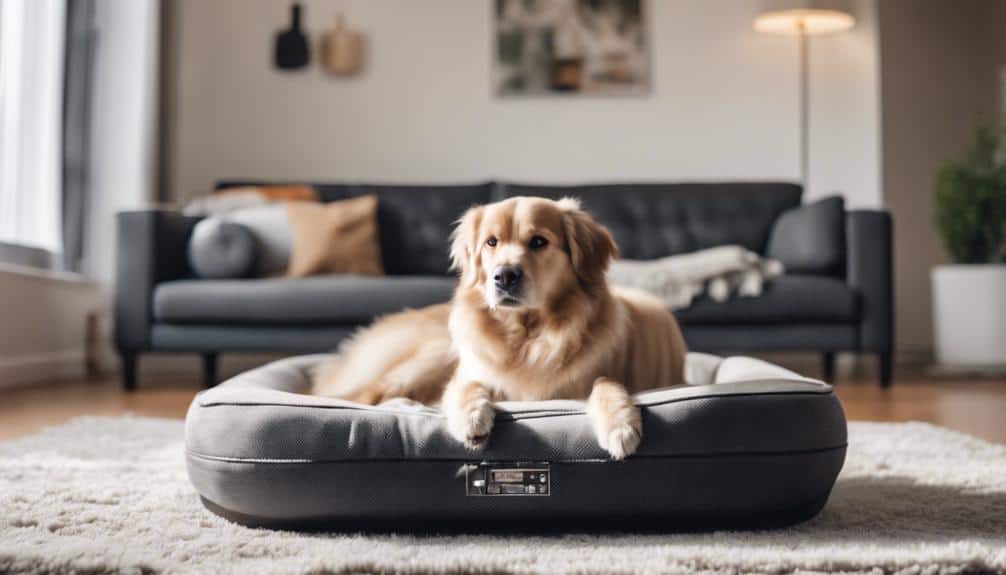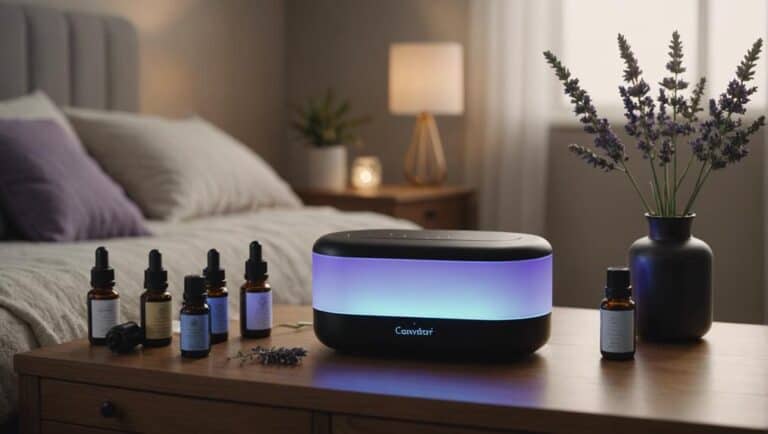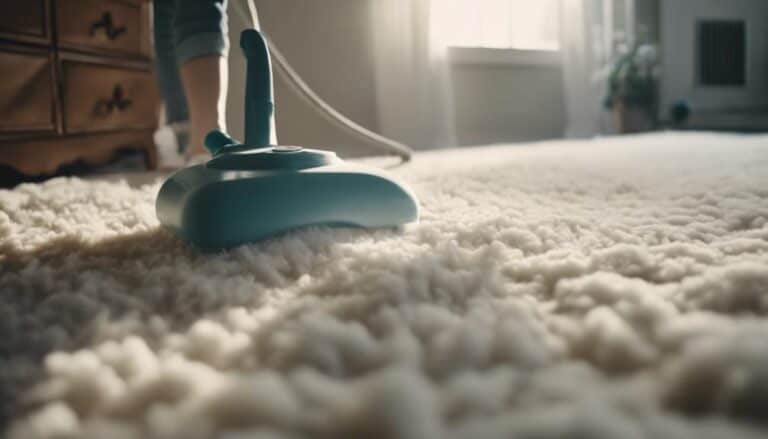10 Tips to Reduce Dog Dander in Your Home Effectively
In the domain of pet ownership, we often hear that ‘prevention is better than cure.’
When it comes to reducing dog dander in your living space, implementing simple yet effective strategies can make a notable difference in maintaining a clean and allergy-friendly environment.
By incorporating these ten practical tips, you can take proactive measures to tackle dander concerns and enhance the overall comfort of your home.
Minimize Pet Contact
To reduce exposure to dog dander in your home, limit contact with pets, especially in areas where people sleep. Dog dander, a common allergen, can trigger reactions in sensitive individuals. Encouraging children with allergies to avoid petting or touching animals can help minimize allergic responses. Additionally, practicing thorough handwashing after interacting with pets is essential to remove allergens effectively.
Restricting pets to rooms with hard flooring, as opposed to carpets, can also help reduce dander levels in your home. Carpets tend to trap more dander, making it harder to remove completely. Implementing strategies to keep pets off furniture and bedding is another practical approach to minimize dander accumulation in areas where people spend a significant amount of time.
Regular Grooming Practices
Regular grooming practices, such as brushing and bathing, play an important role in reducing the amount of dander your dog sheds into your home. Brushing your pet regularly helps to remove loose fur and dander, preventing it from spreading around your living spaces. Bathing your dog can also help reduce dander build-up on their fur. To better illustrate the benefits of grooming, let’s look at the following table:
| Grooming Technique | Effectiveness in Reducing Dander | Best Practices |
|---|---|---|
| Brushing | High | Use a quality pet brush to remove loose fur and dander |
| Bathing | Moderate | Use a pet-friendly shampoo and rinse thoroughly |
| Outdoor Brushing | High | Minimizes indoor dander release |
| Adjusting Frequency | High | Based on your dog’s fur type and shedding patterns |
Implement Air Purification
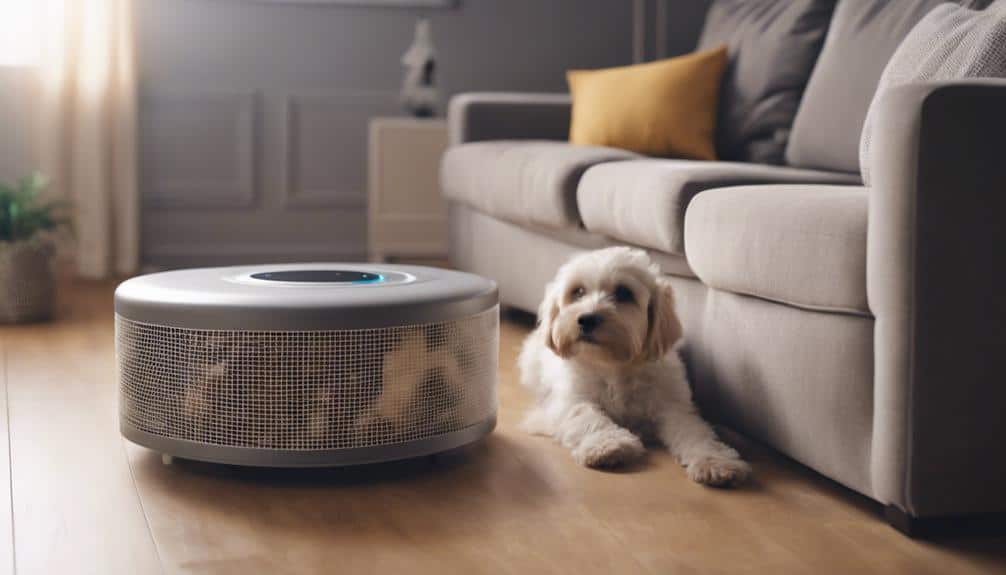
Implementing air purification systems equipped with HEPA filters is important for effectively reducing dog dander in your home. HEPA air purifiers can capture up to 99.97% of pet dander particles, improving indoor air quality greatly.
These filters are specifically designed to trap tiny particles like pet dander, preventing them from circulating in the air. Additionally, air purifiers with activated carbon filters can help neutralize pet odors often associated with dander, creating a fresher environment.
To maximize the benefits, it’s advisable to place air purifiers in frequently used areas to continuously filter out pet dander. Regular maintenance, including filter replacements, is essential to make sure the air purifier operates at its best in combating dog dander.
Opting for air purifiers with multiple filtration stages, such as pre-filters and HEPA filters, enhances their effectiveness in trapping and eliminating pet dander particles. By investing in a quality air purification system with HEPA filters, you can greatly reduce pet dander levels in your home, promoting a healthier living space for both you and your furry companion.
Clean Pet Bedding and Toys
Cleaning pet bedding and toys regularly helps to remove accumulated dander and maintain a hygienic environment for both your pet and your household. It’s recommended to clean pet bedding and toys at least once a week to prevent the buildup of dander and allergens.
When washing pet bedding, using hot water can effectively eliminate dander, dust mites, and other allergens. Opt for a pet-safe detergent to clean the bedding and toys without risking irritation to your pet’s skin. Sanitizing pet toys on a regular basis is also vital to avoid the accumulation of dander and other potential allergens.
To ensure thorough cleaning, consider rotating and washing pet bedding and toys in hot water. This method can help eliminate any hidden dander and allergens that might be present. By maintaining a routine of cleaning pet bedding and toys, you can notably reduce the amount of dander in your home, creating a healthier environment for both your pet and your family.
Vacuum and Dust Frequently
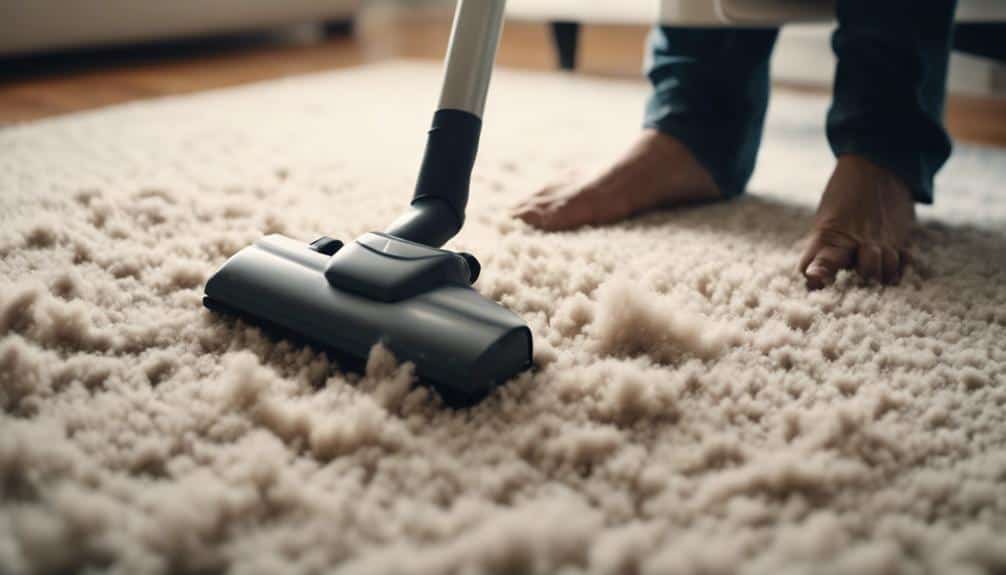
We must emphasize the importance of maintaining a regular vacuuming routine and dusting high surfaces to effectively reduce dog dander in our homes.
Using a vacuum with a HEPA filter can efficiently capture and eliminate dander particles, while dusting with a microfiber cloth helps prevent dander from resettling on surfaces.
Regular Vacuuming Routine
To effectively reduce dog dander in your home, make sure to vacuum and dust frequently, utilizing a HEPA filter to capture airborne particles and allergens. Vacuuming regularly is important for maintaining a dander-free environment.
Here are some essential tips to keep in mind:
- Vacuum carpets, rugs, and upholstery at least twice a week to remove trapped dander.
- Use a vacuum cleaner with a HEPA filter to make certain efficient removal of dander from surfaces.
- Don’t forget to vacuum under furniture, along baseboards, and in hidden corners to eliminate dander reservoirs effectively.
Dust High Surfaces
High surfaces in your home, such as shelves and cabinets, can accumulate dog dander, necessitating regular dusting and vacuuming for effective removal. Dusting these areas with a microfiber cloth or duster helps trap and remove dander, preventing it from resettling. Using a vacuum equipped with a HEPA filter on high surfaces captures and contains dog dander, reducing its presence in the air and minimizing allergic reactions. Regular cleaning of elevated surfaces is vital to prevent dander buildup and maintain a healthier environment for those sensitive to allergies. By incorporating high surface cleaning into your regular home maintenance routine, you can greatly decrease the dispersion of dog dander throughout your living space.
| Benefits of Dusting High Surfaces |
|---|
| Traps and removes dander effectively |
| Prevents dander from resettling |
| HEPA filter in vacuum captures dander |
| Reduces allergic reactions |
| Maintains a cleaner environment |
Maintain Proper Humidity Levels
Maintaining proper indoor humidity levels is important in controlling dog dander. By monitoring humidity and using a hygrometer, we can make sure the air isn’t too dry, preventing dander from dispersing.
Adjusting humidity levels with the help of humidifiers can effectively reduce dander in your home.
Monitor Indoor Humidity
Monitoring indoor humidity levels is essential for reducing dog dander and allergens effectively in your home. Maintaining indoor humidity between 30-50% is critical for controlling dander production and improving air quality.
Here are three key points to contemplate:
- Maintain Ideal Levels: Keep indoor humidity levels within the recommended range of 30-50% to minimize dander and allergens.
- Use Dehumidifiers: Install dehumidifiers in damp areas to prevent moisture buildup, which can lead to increased dander production.
- Regular Monitoring: Use a hygrometer to monitor humidity levels regularly and make adjustments as needed to create an environment less conducive to dander accumulation.
Proper humidity management plays a significant role in reducing dog dander and enhancing the overall air quality in your home.
Use a Hygrometer
To guarantee high-quality dander control, utilizing a hygrometer is essential for accurately measuring and maintaining humidity levels in your home. Maintaining humidity levels between 30-50% can help reduce dog dander in the air. Dry air can cause dander to become airborne more easily, exacerbating allergies. Proper humidity levels can prevent dander from spreading and settling on surfaces. Using a hygrometer to monitor humidity can aid in creating a dander-reducing environment in your home.
| Importance of Hygrometer | |
|---|---|
| Accurate Measurements | Ensures the best humidity levels |
| Dander Control | Reduces airborne allergens |
| Health Benefits | Minimizes allergic reactions |
Adjust Humidity Levels
Wondering how to effectively control dog dander in your home? Adjusting humidity levels within the perfect range of 30-50% is a key strategy to reduce airborne allergens and create a healthier environment for you and your pet. Maintaining proper humidity levels can greatly impact the amount of pet dander present in the air.
Here are some essential tips to help you manage humidity effectively:
- Use a humidifier in dry conditions to prevent dander from becoming airborne.
- Employ a dehumidifier in humid environments to curb mold growth and allergy triggers.
- Regularly monitor and adjust indoor humidity levels to create a more dander-resistant atmosphere for you and your furry companion.
Use Pet-Friendly Cleaning Products
When choosing cleaning products for your home, opt for those specifically designed to effectively remove pet dander and allergens to create a safer environment for all inhabitants.
Pet-friendly cleaning products are formulated to neutralize and eliminate pet dander, addressing allergens and residues left behind by pets. These specialized products promote better indoor air quality by reducing the presence of pet dander on surfaces and in the air.
It’s beneficial to look for plant-based or biodegradable formulas in pet-friendly cleaning products to ensure they’re environmentally friendly while effectively tackling pet dander issues.
Regular use of these products can greatly minimize the impact of dog dander in your living spaces, providing a cleaner and healthier environment for everyone in your home.
Wash Pet Bedding Regularly

Regularly washing your pet’s bedding in hot water is essential for eliminating dander buildup and maintaining a clean living environment. This simple task can greatly reduce pet allergies and create a healthier home environment for both you and your furry friend.
To effectively wash your pet’s bedding, consider the following:
- Weekly Washing: Washing pet bedding weekly in hot water can help eliminate dander buildup and reduce the presence of allergens.
- Hypoallergenic Detergent: Use a hypoallergenic laundry detergent to make sure thorough cleaning of pet bedding without triggering pet allergies.
- Complete Drying: Dry pet bedding completely to prevent mold growth and maintain cleanliness, and consider using a dryer on high heat to effectively kill any remaining allergens.
Establish Pet-Free Zones
We recommend designating specific areas in your home as pet-free zones to reduce dander accumulation.
By implementing restricted zones and blocking off certain spaces, you can minimize allergen exposure.
Establishing these pet-free areas will help maintain cleaner and dander-free environments for those sensitive to allergens.
Designate Specific Areas
To minimize the accumulation of dander in your home, consider designating specific areas as pet-free zones. This practice can help reduce exposure to pet dander and alleviate allergy symptoms. When establishing pet-free zones, focus on rooms where you spend a significant amount of time, such as bedrooms and living areas. By creating these designated areas, you can control where pet dander is concentrated in the house, ultimately improving indoor air quality.
Here are some key points to keep in mind:
- Bedrooms are ideal spaces for pet-free zones to reduce allergen exposure while sleeping.
- Living rooms can also benefit from being pet-free to create a more dander-free environment for relaxation.
- Consider designating a specific area where pets aren’t allowed to help minimize dander-related issues.
Implement Restricted Zones
Consider establishing pet-free zones in your home to effectively reduce the presence of pet dander and create healthier living spaces. By designating specific areas like bedrooms as pet-free zones, you can minimize dander exposure in places where people spend extended periods, therefore decreasing the likelihood of allergic reactions.
This can be particularly beneficial during nighttime, promoting better sleep quality by reducing allergen exposure. Keeping pets out of certain rooms helps greatly decrease dander buildup in those areas, contributing to a cleaner environment overall.
Creating pet-free zones can aid in maintaining an allergen-free space, which is especially advantageous for individuals with pet allergies or asthma. Implementing restricted zones makes certain areas remain free from pet dander, improving the overall air quality in your home.
Block off Certain Spaces
Blocking off certain spaces in your home to establish pet-free zones is an effective strategy for reducing dander accumulation and promoting cleaner, healthier environments. Designating specific rooms as pet-free zones can greatly minimize the spread of pet dander, which is a common allergen. Keeping pets out of certain spaces like bedrooms, where people spend a considerable amount of time, can help decrease allergic reactions and improve overall indoor air quality.
By establishing pet-free areas, you can create a sanctuary within your home that’s free from dander, thereby reducing the risk of allergy symptoms. This simple step can go a long way in maintaining a healthier living environment for everyone in the household.
- Designate specific rooms as pet-free zones to minimize dander accumulation.
- Keeping pets out of certain spaces like bedrooms can reduce allergic reactions.
- Establishing pet-free areas helps maintain cleaner and dander-free environments.
Consult a Veterinarian for Advice
When seeking solutions to reduce dog dander in your home, consulting a veterinarian for personalized advice is essential. Veterinarians can offer tailored recommendations to manage your dog’s dander effectively. They may suggest specific grooming techniques, recommend appropriate products, and address any underlying health issues contributing to dander production. Additionally, veterinarians might propose dietary changes or supplements to enhance your dog’s skin health, ultimately reducing dander levels in your home.
To highlight the importance of consulting a veterinarian for advice, consider the following table:
| Aspect | Veterinarian’s Role | Benefits |
|---|---|---|
| Grooming Techniques | Recommend specific grooming methods to reduce dander production | Minimize dander in your home |
| Health Issues | Address underlying health conditions that contribute to dander production | Improve overall well-being of your pet |
| Dietary Recommendations | Suggest dietary changes or supplements to enhance skin health and decrease dander levels | Enhance skin health and reduce dander production |
Seeking advice from a veterinarian is critical to creating a personalized plan for effectively minimizing dog dander in your living space.
Conclusion
To sum up, implementing these 10 tips to reduce dog dander in your home effectively can greatly improve indoor air quality and minimize allergens. By minimizing pet contact, grooming regularly, and utilizing air purification systems, you can create a dander-resistant environment.
Remember to clean and wash pet bedding, vacuum frequently, and establish pet-free zones to further reduce allergens. Consult with a veterinarian for additional advice on managing pet allergies for a cleaner and healthier home.
